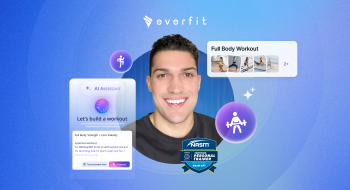Trevor Short is an exercise physiologist at the University of Hawaii, previous coach to NFL / Olympic athletes, & previous COO of a multi-million dollar training studios. Now he’s teaching you the essential concepts of designing a fitness program. You’ll learn how to perform a needs analysis & a comprehensive assessment, the foundational principle of designing a fitness program, and ancillary topics in exercise prescription. Learn the essentials of programming to the next level with these key considerations.
Transcript
Another variable that’s really, really important to consider that can really change the scope of a workout session is rest time. So rest time, I think is something that a lot of coaches, practitioners aren’t measuring as much as they possibly should. And more specifically, it’s really important to measure rest time because rest, right, the longer that you have to rest, the more ATP that the body will be able to regenerate and utilize in that next set. Okay, so with that, yes, that can be important. If you want to improve someone’s overall quality. For example, if you really want to improve someone’s vertical jump, you probably should not have them doing really, really short arrest type loads, or short rest intervals with high loads, because they’re not going to be able to jump as high as they possibly can, by the time that they’re redoing that next exercise of that next sets, you want to have a long, a long work to rest ratio there to allow them to fully perform. Whereas in if you want to apply a bioenergetic stress, right, if you want to get somebody really conditioned, and improve their average power output, or average force output, for average movement quality, right, then having a shorter rest time will be good, because this will have more of a bioenergetic demand. So this all goes back to the needs analysis, what is the work to rest ratio of this individual, what are their needs, are they really, really fit within the phosphagen system, but they have really, really poor cardio, do they need better cardio, are they still subpar with the phosphagen system, and so on. So having a really, really good needs analysis will directly translate into how you prescribe rest time. So with this, to go over this table, really quickly, we have four primary energy system pathways. And we have the phosphagen system, which occurs all out movements from zero to 10 seconds. Proper work to rest ratio here is 1:12. So let’s say you assign an individual a 10 second sprint, for example, a 10 second all out sprint. To optimize the work to rest ratio, this should be 1:12. So that 10 seconds, multiply it by 12 120 seconds, two minutes. So 10 seconds on two minutes off, 10 seconds on two minutes off, sounds like a long, long rest period, right. But if you consider all out full body stimulus, aka a 10 second sprint somewhere around 100 meters maybe 200 meters, right, that’s going to be a lot of stimulus. And they’re going to actually really need that two minutes recover. And as you transition down the columns here, you can see that we work from the phosphagen system, fast glycolytic, slow glycolytic to the oxidative system. And again, the work to rest ratios kind of decrease with that load and intensity specifically. So the phosphagen system bout will be most intense, oxidative system bout would be least intense. So it takes more time to recover from phosphagen bout, right, than it would to recover from an oxidative bout if they were the same duration. However, they have different durations. But all in all, to make sure that you get the primary takeaway here is that based on how long you’re prescribing exercises, right, there are optimal work to rest ratio zones. And this is specific to improving somebody’s performance, right? Not necessarily their energetic capacity. So for example, something like Tabata 20 seconds on 10 seconds off, right? That does not fit into this work to rest ratio column here from the NSCA. However, what that’s going to do is really stress the bioenergetic system, right? And so the bioenergetics will have a big functional adaptation from that. And that individual become a lot more fit from that from a bioenergetic standpoint, but maybe not from a peak power output or peak performance standpoint.















